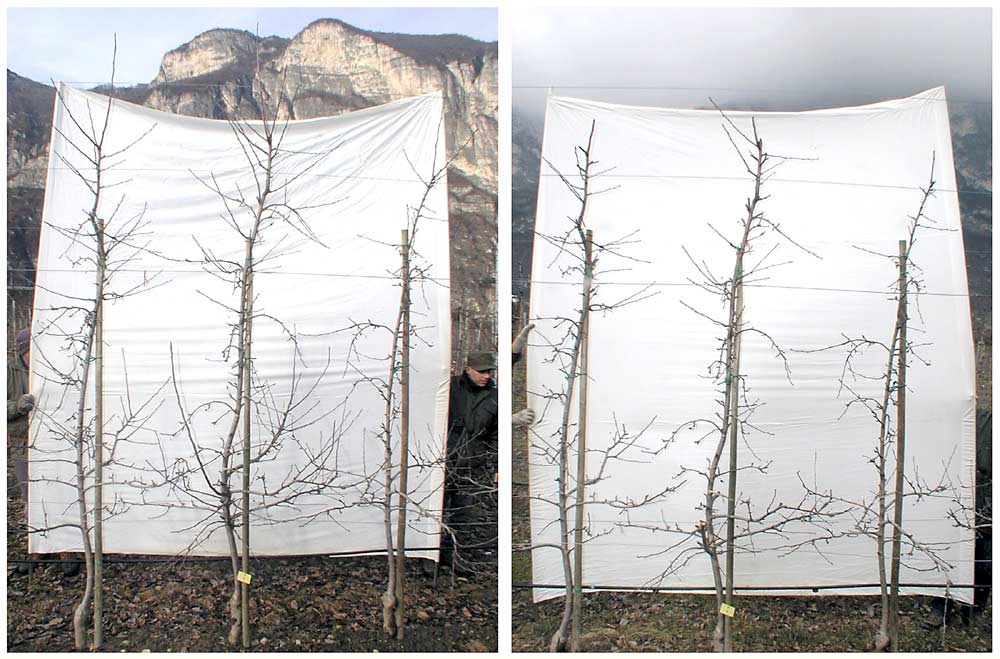
These before (left) and after (right) pruning photos from an orchard in Italy show how the click pruning method keeps the canopy cylindrical to promote better light penetration as high-density orchards mature. (Courtesy Nicola Dallabetta)
In the mountainous Trentino Province in Northern Italy, growers produce 460,000 tons of apples a year on 27,000 acres of orchards. The limited farmable land in the region pushed growers into higher and higher density plantings, with an average of near 1,800 trees per acre today in mostly slender spindle systems. Planting on Malling 9 rootstocks in the same tree rows over generations has further dwarfed the trees and pushed growers to adopt higher densities to maintain production.
But making those high-density plantings productive for the long haul requires growers to switch their pruning strategy to promote branch renewal and maintain a narrow canopy — and many Trentino growers had to learn that lesson the hard way.
“After 12 years, most of the growers were saying that the high-density plantings were not working, but it was the strategy of pruning and tree management that was not working,” said horticulturist Nicola Dallabetta. He spoke at the Great Lakes Fruit, Vegetable, and Farm Market Expo in Michigan in December about the need for a systems-based approach to pruning. “I needed almost 10 years to change their minds.”

Nicola Dallabetta
Dallabetta has worked closely with the region’s apple, cherry and pear growers on production systems in the Trentino region for 25 years in his role at the Technology Transfer Center at the Foundation Edmund Mach in northern Italy. He realized they needed to find an alternative strategy to the traditional long-cut pruning methods that work when you have 1,000 trees per acre, but start to fail when you have a maturing orchard with twice as many trees fighting for the same amount of space and light.
Shifting from a standard pruning strategy that maintains scaffold limbs to a short cut or click pruning strategy that promotes continual branch renewal to improve orchard longevity, yield and fruit quality, he said.
“When you decide on which kind of density you want, you are deciding what kind of pruning you have to apply. It’s very important to respect the planting distances,” he said. It’s difficult to maintain a narrow canopy with sufficient light penetration when trees have complex scaffold branches in high density systems.
It’s a method also espoused by Washington State University’s Stefano Musacchi, research pomologist at the Tree Fruit Research and Extension Center in Wenatchee, Washington, for many apple and pear plantings.
The click method, which was developed in the Netherlands and Belgium to increase light penetration in high-density plantings, includes regularly cutting back young wood to two or three vegetative buds in the top of the tree and in the basic scaffold branches. This creates a constant cycle of branch renewal and stimulates new growth. It creates a cylindrical canopy of simplified lateral branches, all just 1 to 4 years old. Even the basic scaffold branches are periodically removed and only the leader is truly permanent.
Reducing the wood age variability improves fruit size, quality and homogeneity, Dallabetta said.
That’s what makes this intensive style of pruning profitable. His studies have shown that even when growers spent more at the outset to plant more trees per acre, those dense orchards provide a return on investment sooner if an appropriate pruning method such as the click is used.
“Of course, this type of pruning takes more time, about 10 to 20 percent more to use this method,” he said. “But we skip all the summer pruning. And most important for me is to reduce harvest time because we have less picks and we have very homogenous fruit quality. And we save thinning time because we help thin through pruning.”
The simplified architecture also makes it easier to count fruiting buds per branch to get a total crop load set through pruning. And with click pruning, Dallabetta found that fewer chemical thinner applications are required to get the optimum crop load. Typically, two or three sprays were needed in orchards that still used the long-cut pruning method.
Overall, adoption of this pruning method by a majority of growers he worked with in recent years has improved production and supported the trend toward even denser systems, he said, with some orchards now home to 2,400 trees per acre. He acknowledged that for many growers, this change is hard, but it’s critical for growers who want to push into higher and higher densities.
“I understand that some growers prefer to stay where they are, but they have to understand that if they change tree density, then in the same way they have to change the pruning method,” he said. •
—by Kate Prengaman






Leave A Comment